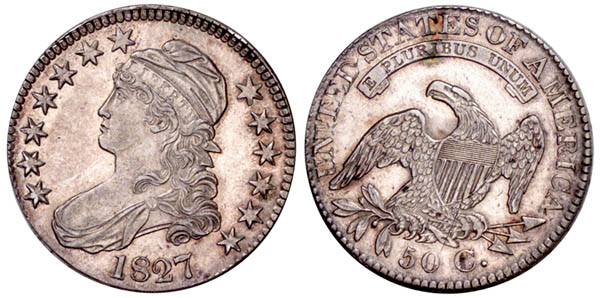Lot 2547
Triple Struck. This example is second finest known according to the article prepared by Russ Logan and discussed below. The fields are fully reflective with the exception of very faint frost around the eagle and within the vertical shield stripes. Very light silvery gray with splashes of darker toning, including an area of iridescence by TE of STATES and just below. A few other spots of toning are visible on the reverse, including on the eagle. The reverse has a light scratch from left edge of the fifth vertical stripe, down to the 0 in the denomination.
The first strike was an obverse brockage with most stars and part of the date visible on the reverse. Remnants of the brockage date may be seen through ES OF A. Remember that the date is incused and mirrored, reading from right to left, and is upside down in relation to these letters with the base of the date closest to the border. Note from this orientation that incuse stars may be seen in both directions through the legend, with stars clearly visible outside the arrowheads. At lower reverse, from the arrowheads clockwise to N of UNITED, incuse dentils from the brockage are visible outside the reverse dentils. The intermediate strike is best viewed on the obverse in the form of doubled stars and doubled dentils. At upper obverse, tripled dentils are actually visible.
Just eight appearances of this variety have been recorded by Steve Herrman. Seven of these were sold via auction with one private treaty sale. The auction appearances have all been for coins with grades from VF-20 to EF-40, and all have sold for between $12,100 and $14,520. We expect this example to bring a similar, or perhaps slightly higher price. The subject of an article by Russell Logan in issue 40 of the Journal. Russ reported grade, provenance, and other notes about each of the 12 known examples of this marriage. This example is second finest of these 12 coins. A most important part of this article had to do with all the problems associated with production of this die marriage. Four of the 12 known examples of this variety are either double or triple struck, each involving an obverse brockage! Overton-149 is not included in the Logan Collection. This extremely rare variety, discovered after the second edition of Overton was published in 1970, is today still only known to the extent of three coins.
Purchased December 4, 1999 from Charles Erb.
